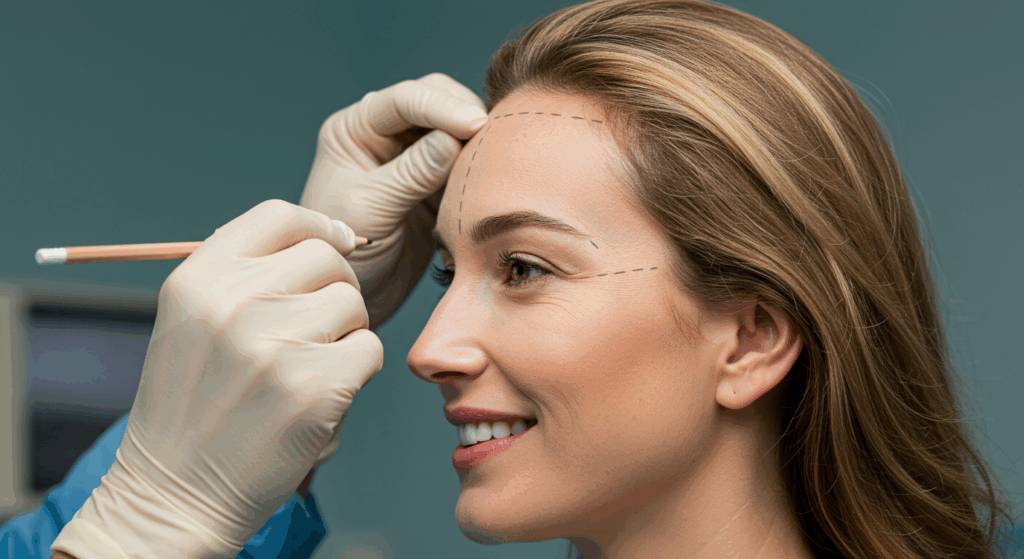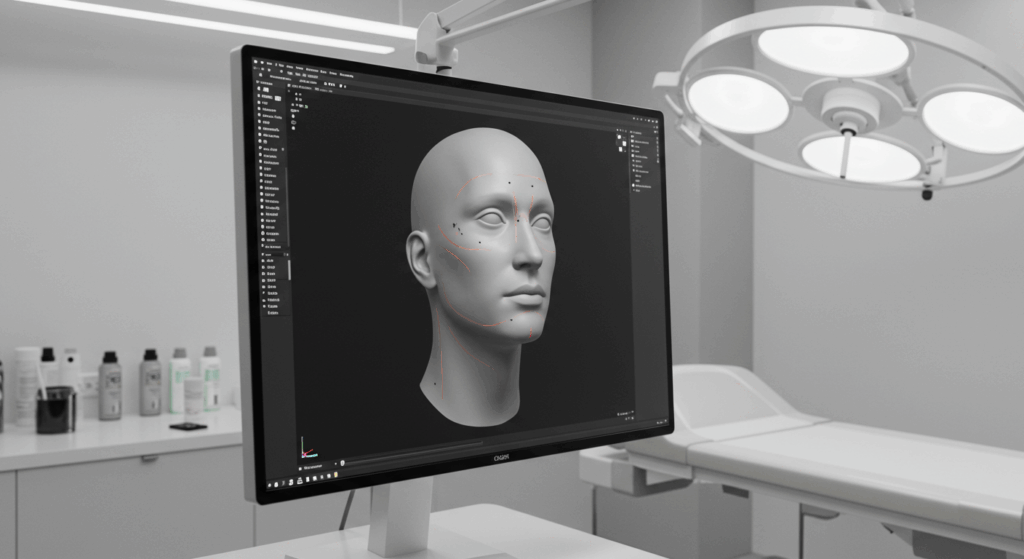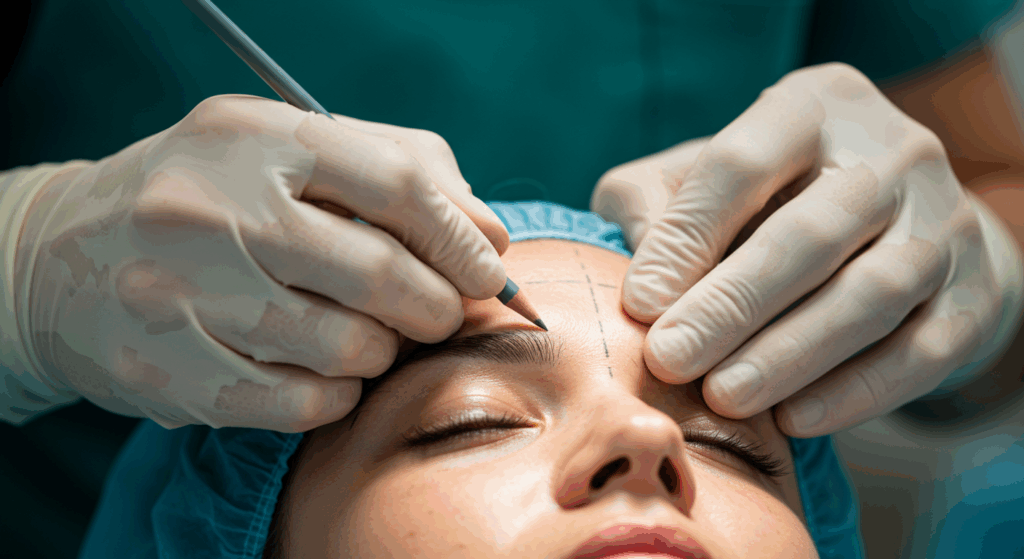The journey toward aligning your physical appearance with your true self is a profound and deeply personal one. For many transgender women and transfeminine individuals, Facial Feminization Surgery (FFS) is not merely a collection of aesthetic procedures; it is a pivotal, life-affirming step toward seeing oneself reflected in the mirror. While many components of FFS contribute to a harmonious result, the upper third of the face—specifically the hairline and temples—acts as the foundational frame. It dictates how light hits the brows, how the eyes are perceived, and sets the overall tone for facial gender expression.
This comprehensive guide is dedicated to exploring two of the most impactful procedures for feminizing the upper face: the Temple Lift and Hairline Advancement. We will move beyond surface-level explanations to provide the in-depth, nuanced information you need—the kind of information essential for making empowered decisions. We will delve into the surgical “how,” the critical “why,” the recovery journey, and the synergistic power of combining these techniques to achieve results that are not just beautiful, but authentic to you.
This is a deep dive, designed for those who have moved past the initial “what is FFS?” queries and are now meticulously researching the specific procedures that will help them achieve their goals.

The “Why”: Understanding the Upper Face and Gender Perception
Gender dysphoria related to facial features is a significant and valid pain point. The constant feeling that your face doesn’t represent who you are can be an exhausting daily burden. The upper face is often a primary source of this discomfort because the characteristics of the forehead and hairline are prominent and difficult to conceal.
Understanding the typical differences between masculine and feminine upper facial thirds is the first step in understanding the power of these procedures.
| Feature | Typically Masculine Presentation | Typically Feminine Presentation |
| Hairline Shape | Higher, often with receding corners, creating an “M” shape. | Lower, more rounded or oval, with softer, less receded corners. |
| Forehead | Taller, wider, and often features a prominent brow bone (brow bossing). | Shorter, narrower, with a smoother, more gently curved contour. |
| Temples | Can appear hollowed or flat. | Fuller and gently curved, creating a continuous, soft line from the forehead. |
| Eyebrow Position | Lower, flatter, and positioned on or below the superior orbital rim (the bone above the eye). | Higher, more arched, with the tail of the brow sitting above the orbital rim. |
A hairline that is perceived as “too high” or a brow that feels “heavy” can lead to being misgendered, a constant source of anxiety and a barrier to feeling safe and comfortable in social situations. The goal of feminizing the upper face is to soften these characteristics and re-establish a quintessentially feminine frame, allowing your inner self to shine through with confidence.
A Hairline Advancement directly addresses the height and shape of the hairline, while a Temple Lift (often performed as part of a Brow Lift) elevates the brows and revitalizes the eye area. When combined, often with Forehead Contouring, they create a powerful, synergistic effect that can dramatically alter gender perception and alleviate dysphoria.

A Deep Dive into the Procedures
Let’s break down the technical aspects, candidacy, and goals of each procedure. This is the information that helps you move from “what is it?” to “is it right for me?”
1. Hairline Advancement (Surgical Scalp Advancement)
Hairline Advancement is a surgical procedure designed to physically lower the position of the entire hairline. It is one of the cornerstones of FFS for individuals with a naturally high hairline.
Who is an Ideal Candidate?
Ideal candidates for a surgical hairline advancement typically possess:
- A High Hairline: The most obvious indication. A surgeon will measure the distance between your brows and hairline to determine if it falls within a masculine range.
- Good Scalp Laxity: This is the most critical factor. Your surgeon will manually test how much your scalp can stretch and move. A flexible scalp allows for a more significant advancement (often 1 to 2.5 cm or more in a single stage) with less tension on the closure.
- Good Hair Density: The incision is made along the hairline, so having dense, healthy hair is important for camouflaging the eventual scar.
- No Significant History of Balding: While the procedure itself doesn’t cause male pattern baldness, it’s a consideration for long-term results.
The Surgical Technique: A Step-by-Step Overview
Understanding the process can demystify the surgery and reduce anxiety.
- The Incision: This is the most artful part of the procedure. A surgeon doesn’t just cut a straight line. They will make a trichophytic incision, which is a beveled, irregular line that follows the natural, slightly uneven pattern of your hairline. This irregular pattern is key to creating a scar that is incredibly difficult to detect once healed. The beveled angle allows hair follicles to grow through the scar, further concealing it.
- Dissection and Release: Once the incision is made, the surgeon carefully dissects the scalp from the underlying bone, lifting it as a single unit (the galea and skin). They work their way back across the scalp, releasing connective tissues to give the scalp mobility.
- Advancement: The entire scalp flap is then gently pulled forward to its new, lower position. The amount of advancement is determined by the pre-operative plan and the scalp’s natural laxity.
- Fixation and Closure: The scalp is secured in its new position using various methods, sometimes including small, absorbable bone anchors (like endotines) or sutures to provide a secure hold during the initial healing phase. This prevents the hairline from retracting. The incision is then meticulously closed with sutures, layer by layer, to ensure a fine-line scar.
What About Hair Transplants?
Hair transplantation (FUE or FUT) is another method used to alter a hairline. It’s crucial to understand how it differs from surgical advancement:
- Hairline Advancement: Physically moves the entire existing hairline forward. The result is immediate in terms of position, and you keep your hair’s existing density. It’s best for lowering the overall hairline.
- Hair Transplantation: Involves moving individual hair follicles from a donor area (usually the back of the head) to the hairline. It’s excellent for “filling in” receded corners, rounding out the shape, and increasing density. However, it takes 9-12 months to see the final results as the new hairs grow in.
In many FFS cases, the two are used together. A surgical advancement lowers the hairline, and then a smaller session of hair transplants can be used months later to perfect the shape and soften the temples, creating the ultimate natural and feminine frame.
2. The Temple Lift (and its relation to the Brow Lift)
While the hairline creates the top of the frame, the temples and brows form the sides. A masculine brow tends to be straight and low. A feminine brow is higher, more arched, and sits above the brow bone, creating a more open, “brighter” eye appearance.
A Temple Lift, often performed as part of a comprehensive Coronal Brow Lift, specifically targets the outer third of the eyebrow.
How a Temple Lift Achieves Feminization:
- Elevates the Brow Tail: Lifting the outer portion of the brow creates a more elegant and distinctively feminine arch.
- Opens the Eyes: By lifting the tissues, it can reduce the appearance of “hooding” on the outer eyelids, making the eyes appear larger and more awake.
- Creates a Smoother Transition: It helps create a seamless, youthful curve from the forehead to the temple and cheek.
The Surgical Synergy
The true magic of upper face FFS lies in how these procedures work together. A Temple Lift or full Brow Lift is almost always performed in conjunction with Hairline Advancement and Forehead Contouring.
Why? They are all accessed through the same coronal incision.
When your surgeon performs the incision for the hairline advancement, they already have access to the underlying structures of the forehead. From this single incision, a skilled FFS surgeon can:
- Advance the Hairline: Lower the hairline as described above.
- Perform Forehead Contouring: Reduce the bony prominence of the brow bossing, smoothing the forehead for a softer, more feminine profile. This is often the highest priority procedure for trans women.
- Execute the Brow/Temple Lift: Release and reposition the brow tissues to their new, more feminine height and arch before closing the incision.
This integrated approach is incredibly efficient. It allows for a complete transformation of the entire upper facial third through one surgical session and one recovery period. It’s the definition of holistic facial feminization—treating the face as one harmonious unit, not as a collection of separate parts.

The Patient Journey: From Consultation to Full Recovery
Knowing what to expect is key to a smooth and positive experience. The journey is a marathon, not a sprint, and being prepared for each stage is empowering.
The Critical First Step: The Consultation
This is your opportunity to interview your potential surgeon. A productive consultation should be a two-way conversation.
What a good surgeon will do:
- Listen intently to your goals, your anxieties, and what “success” looks like to you.
- Perform a physical examination, assessing your scalp laxity, hair density, skin quality, and bony anatomy.
- Use imaging software (like VECTRA 3D) to help you visualize potential outcomes.
- Explain which procedures you are a good candidate for and, just as importantly, which ones you aren’t.
- Show you numerous before-and-after photos of patients with similar starting points to your own. Pay close attention to the quality and invisibility of their hairline scars.
What you should ask:
- “How many hairline advancements have you performed specifically as part of FFS?”
- “What is your preferred technique for fixation?”
- “Can you show me healed photos of your hairline incisions at one year or more?”
- “What is your policy if a revision is needed?”
- “What is your strategy for combining this with forehead contouring and a brow lift?”
The Recovery Timeline: An Honest Week-by-Week Guide
Recovery from upper face FFS is a process of patience. While major discomfort subsides quickly, the final results take time to reveal themselves as swelling resolves and tissues settle.
- First 24-48 Hours: You will wake up with a compression dressing wrapped around your head. Swelling and bruising, especially around the eyes, are at their peak. Discomfort is managed with prescribed pain medication. Your primary job is to rest.
- Week 1: You’ll have a post-op appointment to have the large dressing removed, and often any surgical drains as well. You’ll be able to wash your hair gently. Swelling and bruising will start to migrate down your face. Numbness across the scalp and forehead is completely normal. By the end of this week, sutures or surgical clips are typically removed from the hairline incision.
- Weeks 2-4: You will start to look and feel much more “normal.” Most patients feel comfortable being seen in public (i.e., “socially presentable”) around the 2-3 week mark, though some residual swelling will be apparent to you. You can usually resume light activities and desk work. The incision will be red and visible, but it’s healing.
- Months 1-3: This is a phase of rapid improvement. Swelling continues to decrease significantly. The most dramatic change is the “fluffing” of the brows as they settle into their new position. The hairline scar will begin to fade from red to pink. You may experience some temporary “shock loss” of hair around the incision—this is normal, and it grows back. Sensation will slowly start to return to your scalp, which can feel like tingling or itching.
- Months 6-12: The final results are taking shape. Swelling is now minimal. The scar continues to mature, fading to a pale white line that should be well-hidden by your hair. By the one-year mark, you are seeing what can be considered your final result. The hair that grows through the incision helps to camouflage it almost completely.
Risks, Realities, and Managing Expectations
A trustworthy surgical practice is transparent about risks. While complications are rare with a skilled FFS specialist, they are possible. Understanding them is part of informed consent.
Potential Risks:
- Scarring: The biggest concern for most patients. A well-placed, well-closed trichophytic incision heals remarkably well. However, factors like your individual healing capacity and genetics play a role.
- Hair Loss (Telogen Effluvium): It is common to experience some temporary hair thinning around the incision due to the stress of surgery on the follicles. This “shock loss” almost always resolves, with hair regrowing over the following months.
- Nerve Damage: The nerves that provide sensation to the scalp are stretched during surgery, leading to temporary numbness. Permanent numbness is very rare. The nerves that control facial movement are located much deeper and are not typically at risk with these specific procedures.
- Asymmetry: The human face is naturally asymmetric. A surgeon’s goal is to create balance and harmony, but perfect mathematical symmetry is not achievable or natural.
The Most Important Factor: Your Mindset and Expectations
The goal of FFS is feminization, not the pursuit of an abstract ideal of “perfection.” The most successful outcomes are those where the patient feels the result is natural, harmonious, and, most importantly, looks and feels like her.
Your result will be a feminized version of your own unique facial structure. It’s about bringing your features into a female pattern, not erasing your identity. This mental framework is crucial. Success is waking up, looking in the mirror, and feeling a sense of peace and rightness. It’s the quiet confidence that comes from no longer fearing misgendering. It’s the freedom of moving through the world without the heavy weight of facial dysphoria.
Choosing Your Surgeon: The Ultimate Decision
Your choice of surgeon is the single most important variable in your FFS journey. Given the specialized nature of these procedures, many patients choose to travel to find a true expert—a phenomenon known as medical tourism. Centers of excellence, for instance in places like Istanbul, have become destinations for FFS because they often host surgeons who dedicate their entire practice to transgender-specific surgeries.
What to Look For in a World-Class FFS Surgeon:
- Specialization: Look for a surgeon who doesn’t just “offer” FFS, but specializes in it. A significant portion of their practice should be dedicated to FFS.
- Board Certification: Ensure they are certified by a reputable board of plastic and reconstructive surgery.
- An Extensive FFS Photo Gallery: They must have a large portfolio of high-quality before-and-after photos specifically showing hairline advancements and brow lifts on transgender patients. Look for consistency, natural results, and well-hidden scars.
- Aesthetic Congruence: Do you like their results? Does their “style” resonate with your goals? Some surgeons have a more dramatic aesthetic, others more conservative. Find one whose work aligns with your vision.

Conclusion: Framing Your Authentic Future
The decision to undergo FFS is a monumental one. Procedures like the Temple Lift and Hairline Advancement are far more than cosmetic tweaks; they are powerful tools for sculpting the frame of your face to match your identity. By lowering the hairline, smoothing the forehead, and lifting the brows, this integrated approach to the upper face can profoundly reduce gender dysphoria and provide a foundation of confidence from which you can live more freely and authentically.
The journey requires meticulous research, patience through recovery, and a deep partnership with a surgeon you trust. But the ultimate reward—seeing a reflection that finally feels like home—is immeasurable.
Visit Dr.MFO Instagram profile to see real patient transformations! Get a glimpse of the incredible results achieved through facial feminization surgery and other procedures. The profile showcases before-and-after photos that highlight Dr. MFO’s expertise and artistic vision in creating natural-looking, beautiful outcomes.
Ready to take the next step in your journey? Schedule a free consultation with Dr. MFO ( Best Facial Feminization Surgeon for You) today. During the consultation, you can discuss your goals, ask any questions you may have, and learn more about how Dr. MFO can help you achieve your desired look. Don’t hesitate to take advantage of this free opportunity to explore your options and see if Dr. MFO is the right fit for you.










